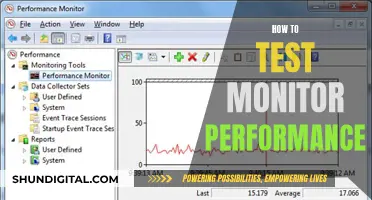
A 24-hour pH monitoring study is a test to assess whether acid is flowing back into the oesophagus from the stomach, causing pain, nausea, heartburn, and chest pain. The test involves inserting a narrow, flexible tube through the nose into the oesophagus, where it remains for 24 hours, delivering data to a small computer. During the test, patients can go about their normal activities, including eating and drinking, and will keep a diary of their symptoms and food intake. The test can show if a patient has acid reflux or gastroesophageal reflux disease (GERD) and can also be used to evaluate the effectiveness of treatment for GERD.
| Characteristics | Values |
|---|---|
| Purpose | To assess whether acid is coming back into the oesophagus from the stomach, causing pain, nausea, heartburn, and chest pain. |
| Procedure | A narrow flexible tube is placed through the nose into the oesophagus. The tube remains in place for 24 hours, delivering data to a small computer. |
| Preparation | Patients should not eat or drink for four to six hours before the procedure. They may also be asked to stop taking certain medications, such as antacids, for 24 hours or longer. |
| Side Effects | Runny nose, sore throat, slight discomfort when swallowing. Very occasionally, some patients may feel faint during the procedure. There is a small risk of bleeding from damage or perforation to the nose or larynx. |
| Recovery | The tube is removed the next day. Results are typically discussed at the next outpatient appointment. |
What You'll Learn

The procedure involves inserting a thin tube through the nose and into the oesophagus
A 24-hour pH monitoring study is a test to assess whether acid is flowing back into the oesophagus from the stomach, causing pain, nausea, heartburn, and chest pain. The procedure involves inserting a thin, flexible tube through the nose and into the oesophagus. This tube is called a catheter.
Before the procedure, the patient's nose is numbed with a local anaesthetic gel or spray. The patient may also be asked to fast and refrain from taking certain medications for a specified period before the test. During the procedure, the patient swallows sips of water to help guide the catheter down to the oesophagus. The catheter is then secured with tape and connected to a small recording device or monitor, which the patient wears around the waist or over the shoulder.
The catheter remains in place for 24 hours while the patient goes about their normal daily activities, including eating, drinking, sleeping, and working. The patient will also keep a diary of their symptoms, food intake, and activities during this time. The catheter measures the levels of acid refluxing into the oesophagus and transmits this information to the recording device.
After the 24-hour period, the patient returns to the doctor or nurse, who removes the catheter and downloads the data from the recording device. This data is then used to evaluate the changes in acid levels throughout the period and make a diagnosis. The entire procedure is safe and typically causes only minor discomfort, but rare complications can include a nosebleed or tearing of the oesophagus.
Blind Spot Monitor: Standard on Rav4 XL?
You may want to see also

The test measures how often acid enters the oesophagus and for how long
The 24-hour pH monitoring study is a test that measures the frequency and duration of stomach acid entering the oesophagus, or the tube that carries food and liquids from the mouth to the stomach. This condition is known as acid reflux or gastroesophageal reflux disease (GERD).
During the test, a thin, flexible tube is inserted through the nose and into the oesophagus. The tube is then connected to a small monitor that the patient wears around their waist or shoulder. The monitor measures the patient's acid levels for 24 hours, during which they keep a diary of their symptoms, food intake, and activities. The following day, the tube and monitor are removed, and the patient submits their diary to be compared with the monitor's data.
The test can show whether the patient has acid reflux or GERD, as well as evaluate the effectiveness of any GERD treatments. It can also help determine if acid reflux is related to unexplained asthma or other respiratory symptoms.
The 24-hour pH monitoring study is an important test for diagnosing or monitoring GERD and can help identify other possible health conditions that could be causing GERD-like symptoms. While the test is generally safe, patients may experience some mild discomfort in their nose and throat, as well as a sore throat or gagging sensation during the procedure.
Monitoring Android CPU Usage: A Comprehensive Guide
You may want to see also

It can help diagnose acid reflux or GERD
A 24-hour pH monitoring study is a test to assess whether acid is flowing back from the stomach into the oesophagus, causing symptoms such as pain, nausea, heartburn, and chest pain. The test can be used to diagnose acid reflux or gastroesophageal reflux disease (GERD).
Acid reflux, or gastroesophageal reflux (GER), occurs when stomach acid flows back into the oesophagus, the muscular tube that carries food and liquids from the mouth to the stomach. This can cause a burning feeling in the chest or neck, known as heartburn. GERD is a more serious and long-lasting form of reflux, with repeated symptoms that can lead to complications over time.
The 24-hour pH monitoring study involves placing a thin, flexible tube called a catheter through the nose into the oesophagus, or using a wireless pH probe, a small capsule-like device. The catheter or probe will measure the pH level in the oesophagus for 24 to 96 hours. The test can show how often stomach acid enters the oesophagus and how long it stays there.
During the test, the patient will keep a diary of any symptoms they experience, as well as recording the times they eat and lie down. After the test, the patient will meet with their healthcare provider to review the data from the sensor and the diary.
The 24-hour pH monitoring study is particularly useful for diagnosing acid reflux or GERD when symptoms are present but an endoscopy exam does not detect any evidence of reflux disease, or when standard treatments are not effective. It can also be used to monitor the effectiveness of treatments for GERD.
Interpreting the results of a 24-hour pH monitoring study involves visual inspection, computer calculation, and symptom correlation. Typically, the pH level in the oesophagus should be close to 7.0, and lower levels, such as below 4.0, indicate a surge of stomach acid. However, it's important to differentiate between reflux episodes and gradual acidification, as the latter can be due to oesophageal retention.
Touch Monitors: Worth the Investment?
You may want to see also

The patient must keep a diary of symptoms, food eaten, and timings
A 24-hour pH monitoring study is a test to assess whether acid is flowing back into the oesophagus from the stomach, causing symptoms such as pain, nausea, heartburn, and chest pain. During the test, a thin, flexible tube is inserted through the patient's nose and guided into their oesophagus. The patient is required to keep a diary of their symptoms, food intake, and timings for the duration of the test, which is typically 24 hours. This diary is an essential component of the study as it helps to correlate symptoms with acid exposure events.
The diary should include detailed information about the patient's symptoms, such as the type and intensity of each symptom experienced, as well as the exact times they occurred. It is important to record the timings of symptoms accurately, as this information will be used to correlate the symptoms with the acid exposure data collected during the test.
In addition to symptom recording, the diary should also include a log of all food and drinks consumed during the 24-hour period. This includes not only meal times but also any snacks or beverages, along with their respective timings. This information is crucial as certain foods and drinks can trigger acid reflux, and it helps the doctor interpret the results of the study.
Furthermore, the diary should also include the timings of certain activities, such as lying down or sleeping. These activities can also impact acid reflux, and including them in the diary provides a more comprehensive understanding of the patient's condition. The patient should aim to record the timings as accurately as possible, ideally noting the exact times for each entry in the diary.
Keeping a detailed diary during the 24-hour pH monitoring study is essential for the accurate diagnosis and treatment of conditions like gastroesophageal reflux disease (GERD). It empowers doctors to correlate symptoms with acid exposure, make informed treatment decisions, and provide relief to patients suffering from uncomfortable symptoms.
Cutting Off: Removing Electronic Monitoring Bracelets Illegally
You may want to see also

The tube is removed the next day
The patient will return to the hospital to have the tube removed. The doctor will then download the data from the computer and use it to analyse changes in acid levels throughout the 24-hour period. This data will be used to make a diagnosis and plan treatment.
The patient will also hand over their diary, in which they have recorded their symptoms, food eaten, and any other activities over the 24-hour period. This will help the doctor to correlate the patient's symptoms with the acid level data.
If the data shows that the patient has GERD or another problem, the doctor will discuss treatment options with the patient.
Maximizing Asset Performance: Claims Monitoring Benefits
You may want to see also
Frequently asked questions
It is a procedure that measures how often fluid flows back into your oesophagus from your stomach and the acidity of this fluid over a 24-hour period. This helps diagnose acid reflux or GERD (gastroesophageal reflux disease).
A thin, flexible tube called a catheter is inserted through the nose and guided into the oesophagus. The catheter stays in place for 24 hours, transmitting data about acid levels to a small recording device that the patient wears.
Before the procedure, patients are advised to not eat or drink anything for a few hours and may need to stop taking certain medications. After the 24-hour period, the patient returns to the hospital to have the tube removed, which takes about 5-10 minutes.
Patients can continue their normal daily activities, including eating and drinking. However, they must avoid certain foods and drinks, such as acidic foods, citrus fruits, and fizzy drinks. They must also avoid taking indigestion medication and showering or bathing.
Common side effects include a runny nose, sore throat, and slight discomfort when swallowing. There is a small risk of complications such as bleeding or damage to the nose or larynx (voice box).







